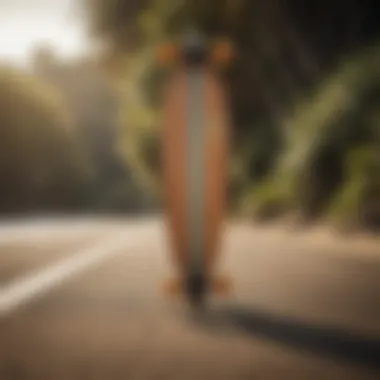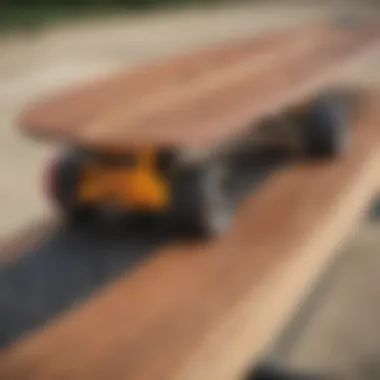Top Longboards: A Detailed Guide to Selection and Performance


Intro
In the lively world of longboarding, understanding the intricate details of gear selection can transform your riding experience. It’s not merely about hopping on a board and gliding through the streets; it’s about finding the right companion for your adventures, whether you’re cruising, carving, or navigating downhill slopes. Choosing the right longboard involves weighing various factors — from construction materials to specific riding styles. These choices can greatly influence your performance and enjoyment on the board.
This guide will immerse you in the essentials of longboards. We'll explore vital aspects, such as materials and designs, while highlighting well-regarded brands that continuously rise to the forefront in both performance and durability. We'll also touch on riding techniques that suit different boards, provide maintenance insights to prolong their life, and discuss how current trends might shape rider preferences moving forward.
Surf Gear and Equipment
In the context of longboarding, the phrase 'surf gear' may seem out of place for some, yet the principles of selection bear similarities to those found in surfing. The type of longboard you choose is akin to the surfboard design best suited for your style. Here’s a breakdown of essential components to evaluate during your search for the perfect longboard:
Construction Materials
Choosing a longboard necessitates an understanding of the materials used in its construction. This directly impacts not just durability but also overall ride quality. Key materials include:
- Maple Wood: Known for its stiffness and responsiveness, maple is a classic choice. Pro riders often prefer it for its excellent energy transfer and stability.
- Bamboo: Lightweight and flexible, bamboo boards offer a smooth ride with plenty of pop. Perfect for those who enjoy tricks and freeriding.
- Fiberglass: Commonly used in hybrid designs, fiberglass adds durability while keeping the board lightweight. These are often favored by downhill riders who require speed and control.
- Carbon Fiber: For the serious enthusiasts looking for performance, carbon fiber offers exceptional rigidity without bulk.
Design Types
Longboards are designed for various riding styles, and understanding these styles can guide aspiring longboarders to the right board. Here are some popular designs:
- Cruisers: Shorter and typically wider, cruisers are built for smooth, casual rides. They are great for commuting and city riding.
- Freeride: These boards usually have a symmetrical shape, making it easier to slide and perform tricks. They cater to riders who enjoy a mix of carving and tricks.
- Downhill: These boards are generally longer and stiffer, perfect for gripping at high speeds on steep hills. Stability is key here.
- Long Distance: Optimized for comfort, long-distance boards often have a flexible deck that absorbs bumps better, making them ideal for those seeking extended rides.
"Selecting the right construction material and design will not just improve your performance, but also enhance the comfort of your longboarding experience."
Essential Accessories for Longboarders
Beyond the board itself, the right accessories can make a world of difference. Here's a quick look at must-have items:
- Protective Gear: Helmets, knee pads, and elbow pads are essential, particularly for beginners and those venturing into downhill riding.
- Quality Wheels: Different wheel durometers and diameters affect the ride. Softer wheels offer grip but wear faster, while harder wheels are perfect for sliding but may sacrifice comfort.
- Board Bag: To protect your board during transport and storage is essential, especially if you plan to travel.
- Maintenance Kit: Keeping your bearings, trucks, and wheels in good shape ensures a smoother ride and prolongs the life of the board.
With these fundamentals under your belt, you will not just roam aimlessly but will ride like you mean it. The right gear paves the way for enjoyable sessions, whether you're just starting or have been longboarding for years. As we move forward, we’ll examine techniques, skills, and the etiquette that enhance both the sport and community of longboarding.
Understanding Longboards
When it comes to longboarding, grasping the foundational aspects is just as crucial as picking the right board for your style. Understanding longboards not only helps riders make informed purchases but also enhances their overall experience. This section dives into what defines a longboard and traces its journey through time to see how it has morphed into what it is today.
Defining Longboards
Longboards are an extended version of traditional skateboards, designed for a smooth glide and stability. Generally, they are characterized by their longer decks, which provide the rider more space when balancing and maneuvering. The typical length of a longboard ranges from 33 inches to over 60 inches, with a wider stance that supports various riding styles—from cruising to downhill racing. Key features include wider trucks, larger wheels, and a more flexible deck design.
Notably, longboards offer a unique riding experience. They typically consist of:
- Wider Decks: This adds stability, allowing for a more relaxed stance.
- Large Wheels: These wheels provide better grip and can roll over uneven surfaces with ease.
- Reduced Weight: Many boards are made from lightweight materials, promoting ease of transport.
Each of these elements plays a role in enhancing the rider's ability to negotiate curves, hills, and even crowded streets; especially for those who prefer their ride smooth and effortless.
The Evolution of Longboarding
Longboarding has a rich history that dates back to the 1950s. Initially, surfers wanted a way to practice their skills on land, leading to the creation of the first longboards. Back then, these boards were simple wooden creations, lacking the sophistication of today's models. Over the years, the development of materials and technology has not only refined the construction of longboards but also expanded the community around them.
As time rolled on, various styles emerged, each catering to different aspects of riding. The late '70s and early '80s saw the introduction of things like downhill longboarding, where riders would speed downhill at high velocities, adapting their boards for both control and performance.
Moving into the new millennium, innovations in design and materials have transformed longboarding dramatically. Companies started experimenting with composite materials, enhancing strength while reducing weight. Furthermore, the rise of electric longboards in recent years marks a significant shift, appealing to those looking for an easier ride with minimal physical exertion.
To put it simply, longboarding has moved from a niche pastime to a worldwide sport and a form of transportation that appeals to various demographics. From casual riders to serious competitors, the evolution of longboards is a compelling reflection of creativity, community, and continuous improvement.
"Longboarding is not just a sport; it’s a culture, a lifestyle that transcends borders and connects people."
In understanding longboards, we can appreciate the sophisticated blend of design, function, and culture that defines this mode of transport and recreation. For anyone intending to make a decision on which longboard suits their needs, grasping these fundamental aspects becomes paramount to enhancing one's riding experience and choice.
Types of Longboards
Understanding the different types of longboards is crucial for any rider, whether you’re a neophyte looking to take your first ride or an experienced skater searching for an upgrade. Each variant comes with its own unique characteristics, catering to various riding styles, terrains, and personal preferences. The landscape of longboarding is as diverse as the riders themselves, and there’s something for everyone.
When choosing a longboard, it's paramount to consider what you'll primarily use it for. Some boards excel in cruising, while others shine in downhill racing or maneuvering through freestyle tricks. The distinction between these types is not just academic; it affects performance, comfort, and the overall riding experience. Let’s break down some of the most popular categories.
Cruisers
Cruisers are, as the name suggests, designed for a smooth and easy ride. Typically shorter and wider than other longboards, they are perfect for casual cruising around town or enjoying a serene ride through the park. The flexibility in design allows for comfortable foot placement and easy turns. A cruiser is ideal for those who don’t want to push themselves too hard but rather enjoy the journey.


Benefits of Cruisers:
- Easy Maneuverability: The compact size lets riders navigate tight spaces effortlessly.
- Comfort: With larger wheels, they absorb bumps well, providing a smooth ride on uneven surfaces.
- Accessibility: They are great for riders of all skill levels, making them a popular choice among entry-level skaters.
Downhill Longboards
If you’re craving speed, downhill longboards might just be your cup of tea. These boards are typically longer and lower to the ground, providing stability at high speeds. The design emphasizes aerodynamics and control, making it easier for riders to carve down hills without feeling like they might wipe out at any moment.
Considerations for Downhill Longboards:
- Stability at Speed: Longer wheelbases create a steadier ride.
- Strong Trucks: They come with robust trucks to handle sharp turns and rapid descents.
- Wheel Hardness: Harder wheels are common to reduce drag, making this style ideal for smooth surfaces.
Freestyle Boards
Freestyle boards open up a world of creative expression on wheels. These boards are designed to perform tricks and stunts, allowing riders to showcase their skills. They are often shorter and lighter than downhill boards, providing more control for flips and spins. The only limit here is your imagination—and perhaps, your balance.
Highlights of Freestyle Boards:
- Versatility: Suitable for a variety of tricks.
- Lightweight Construction: Easy to handle during complex moves.
- Varied Shapes: Available in several shapes that enhance performance on various tricks.
Pintail Longboards
Characterized by their elongated, tapered shape at both the nose and tail, pintail longboards are classic in design and form. These boards are designed for cruising and carving. They’re not built for tricks but rather to glide smoothly and elegantly down the road or ramp. The shape allows for easy weight shifting, making them great for beginners wanting a reliable board for their leisurely rides.
Why Choose a Pintail?:
- Graceful Turns: The design allows you to carve effortlessly.
- Stability: The long, stable deck reduces wobbling, even at leisurely speeds.
- Aesthetic Appeal: They often boast beautiful designs and solid wood finishes, attracting riders who value style alongside substance.
Electric Longboards
A modern twist on the classic longboard, electric longboards have gained traction as technology advances. These boards come equipped with motors and are operated via a handheld remote, allowing you to travel distances with ease. They hold significant appeal for commuters or riders seeking a less strenuous way to enjoy longboarding, without sacrificing the thrill.
Features of Electric Longboards:
- Convenience: Easily glide up hills without breaking a sweat.
- Speed Settings: Many models offer multiple speed settings, suitable for various skill levels.
- Battery Life: Current models boast impressive battery life, allowing for longer rides without constant recharging.
Understanding these various types of longboards is indispensable for making an informed purchasing decision. Each type caters to specific needs and riding styles, ensuring that regardless of your experience level, there's a longboard suited perfectly for you.
Key Features to Consider
When it comes to selecting a longboard that meets your specific needs, understanding the key features is paramount. These elements can greatly influence your riding experience, comfort, and safety. Knowing what to look for makes all the difference, whether you're a seasoned rider or just starting out. Here, we will dive into crucial aspects like deck materials, wheel sizes, and truck types that can play a pivotal role in optimal longboarding performance.
Deck Material and Construction
Wood Types
Wood is historically the preferred material for longboards, favored for its natural flex and aesthetic appeal. The primary wood types used include maple, bamboo, and plywood. Maple, for instance, offers resilience and is robust, making it an excellent choice for downhill riding. Bamboo, on the other hand, stands out for its lightweight and flex properties, lending itself well to cruising styles.
Advantages of wood stems from its vibration absorption; it gives a softer ride over rough terrain. Yet, it's worth noting that wood may not hold up against water damage as effectively as some synthetic materials.
Composite Materials
Composite materials use a mix of fibers and plastics to create a strong yet flexible board. Many boards utilize fiberglass or carbon fiber in their construction for increased durability and lower weight. The key characteristic of composite boards is that they can be engineered to achieve specific flex patterns, which can greatly benefit performance on different terrains.
The downside is the price; they tend to be more costly than their wooden counterparts but make up for this with longevity. In various longboarding contexts, such materials contribute to precisely tuned performance, making them popular among advanced riders.
Flexibility and Durability
Flexibility in a longboard can drastically affect your riding style and comfort. A flexible deck can absorb shocks and provide better maneuverability on tight turns, whereas a stiffer deck boasts longevity and stability at higher speeds. Durability is equally vital; the choice between flexibility and durability often depends on what kind of riding you plan to do. Consequently, understanding how each feature interacts is crucial in selecting your longboard. Flexibility impacts how a board handles imperfections in terrain, while durability often suits those engaging in more aggressive riding styles. Knowledge of these aspects can greatly aid in making an informed decision.
Wheel Size and Hardness
Wheel size and hardness directly correlate with how a longboard performs on different surfaces. Larger wheels generally glide better over rough surfaces, providing a smoother ride. They often range from 55mm to 75mm or more. Harder wheels (measured on a durometer scale) offer better grip and slide when needed but can be unforgiving on bumpy surfaces. Softer wheels, conversely, absorb impact better but sacrifice speed and efficiency on smoother pavement. Being mindful of these features can lead riders to a more enjoyable longboarding experience that accommodates their environment and preferences.
Truck Types
Standard Trucks
Standard trucks feature a simple design that excels in stability for beginners and casual riders. These trucks allow the board to turn smoothly without requiring extensive knowledge of techniques. Their popularity lies in the balance they strike between maneuverability and control. Standard trucks can be easier to maintain, contributing to less time fiddling with adjustments. However, for advanced riders who seek aggressive handling and performance, standard trucks might feel limiting. Therefore, understanding your skill level and riding goals is key when considering whether to opt for these.
Reverse Kingpin Trucks
Reverse kingpin trucks are designed for a different purpose altogether. They offer better maneuverability and a greater lean angle, which is ideal for carving and downhill riding. The geometry of these trucks allows for snappier turns and a smoother ride at speed. Riders will often find them more responsive compared to standard trucks, especially when navigating tight corners. However, because of their sensitivity, they may not provide the stability some riders seek at high speeds, requiring a more advanced skill level to handle effectively. Assessing your style and comfort with performance can help you decide whether these trucks fit your longboard needs.
In sum, knowing the various features of a longboard is essential for making an educated purchase. When you appreciate how different materials, wheel sizes, and truck types affect your ride, you’ll be better positioned to secure a longboard that enhances your skills and suits your riding environment.


Popular Longboard Brands
The world of longboarding has seen many brands rise to prominence, each with unique offerings and characteristics. Understanding the significance of these popular brands is crucial, especially for those diving into longboard selection. They serve not only as benchmarks in quality and performance but also play a role in shaping rider preferences and experiences.
When it comes to longboards, the brand can often be a reflection of both quality and innovation. Established brands usually have a reputation built on consistent performance, while new ones might introduce groundbreaking designs or eco-friendly initiatives. Hence, selecting a longboard from a recognized brand can simplify the decision process, offering riders confidence in their choice.
Loaded Boards
Loaded Boards is revered in the longboarding community. Known for their premium craftsmanship, they specialize in freestyle and downhill boards that cater to diverse riding styles. Their boards often highlight bamboo and fiberglass materials, resulting in lightweight yet sturdy options.
Riders appreciate Loaded’s attention to detail in design and performance tuning. Their curved flex patterns allow for a unique riding experience, especially in the freestyle domain, enabling easier tricks and maneuvers. Plus, the aesthetics of Loaded Boards often appeal to a young, vibrant audience, blending functionality with artistic design.
Land Yachtz
Land Yachtz is another leader, often recognized for their artistic designs and durability. The brand offers a broad spectrum of longboards, from pintails to drop-through models, accommodating various riding preferences. Their boards are designed to withstand rough handling while providing a smooth riding experience.
One notable aspect of Land Yachtz is their commitment to customization. Riders can find limited edition designs and vibrant colors that enhance the personal feel of the board, making it a standout choice among many. This brand delivers on not just the product's performance but also on its visual appeal, striking a balance that many riders seek.
Sector
Sector 9 holds a strong position in the longboard market, especially for beginners and casual riders. This brand offers a range of affordable, user-friendly boards perfect for those just starting. Sector 9 is well-known for its excellent stability and smooth ride, making it a favorable choice for cruising.
Moreover, their focus on sustainable practices resonates with environmentally-conscious riders. They have implemented initiatives to create eco-friendly boards, ensuring a minimal carbon footprint. Plus, the diverse board types include everything from cruisers to downhill boards, emphasizing versatility in their offerings.
Arbor Skateboards
Arbor Skateboards is unique in its strong emphasis on sustainability. Each board they produce is crafted with eco-friendly materials, including reclaimed wood and non-toxic finishes. This commitment speaks to a segment of riders who value environmental responsibility alongside performance.
Beyond their green ethos, Arbor’s designs shimmer with uniqueness. Their boards are visually appealing, often inspired by nature and art. Arbor combines style with functionality, ensuring riders do not have to sacrifice aesthetics for performance. It's a choice that resonates with both style-conscious and ethically-minded consumers in today’s market.
"When selecting a longboard, considering the brand can lead to better performance and riding experiences. Established brands often bring the benefits of years of innovation and community feedback."
Choosing the Right Longboard
When it comes to longboarding, the journey really starts with the right selection. This section is crucial because choosing the proper longboard can significantly impact your experience on wheels. Selecting a board that suits your personal preferences, riding style, and skill level isn’t just about having fun; it means safety, control, and ultimately, a more rewarding ride.
Skill Level and Riding Style
Understanding your skill level is paramount. For instance, a beginner might be better off with a stable cruiser, while an experienced rider might gravitate towards a nimble downhill longboard. Each type of board is designed with specific characteristics suited to various proficiencies.
- Beginners: If you’re just starting out, look for boards that offer stability and ease of steering. Longboards like the Arbor Axis are a great choice. They have a wider deck and softer wheels, making it less likely to topple over when learning to balance.
- Intermediate Riders: Once you get the hang of things, you might want to try something like a loaded Vanguard, which allows for more agility while still offering a good grip.
- Advanced Riders: For those who have mastered the basics, you could opt for a downhill longboard. These boards, such as the Land Yachtz Dinghy, are designed for speed and require a deft touch to handle safely. Their narrower width and stiffer construction cater to the needs of skilled riders, allowing for quick turns and reliable performance at high speeds.
It’s also vital to consider your riding style. Are you more into smooth cruising along the boardwalk or do you find yourself navigating steep downhill slopes? The former environment might prefer a pintail, while the latter would demand a drop-through deck designed for speed and control.
Terrain and Usage
Your choice of longboard should reflect the environment in which you plan to ride. Different terrains call for different specifications. Riding on varied surfaces not only affects the type of wheels but also the board design.
- Urban Rides: If you plan to cruise down city streets, focus on versatility. A board like the Sector 9 Lookout can handle street bumps smoothly due to its larger wheels and flex. The design allows you to weave through traffic while getting some speed without sacrificing control.
- Hilly Areas: For downhill enthusiasts, look for a stiffer deck with smaller, hard wheels that grip the ground. Brands like Loaded produce boards specifically for downhill rides, providing the kind of stability you need when zipping through curves.
- Paved Paths or Parks: If your longboarding mainly happens in parks or along smooth paths, you might prefer a freeride or a trick board that can withstand the wear and tear of tricks and slides.
"Choosing the right longboard not only enhances the riding experience but also ensures safety and enjoyment on and off the board."
Before making a decision, it’s useful to test ride different boards if that’s an option. The feel of the board under your feet is incredibly personal; your choice should resonate with how you envision your rides properly. In a nutshell, understanding your skill level and how you intend to use your longboard are pivotal decisions you must consider.
Longboard Maintenance and Care
Keeping your longboard in prime condition is crucial for both performance and longevity. Just like a car needs regular maintenance to run smoothly, your longboard should be taken care of to ensure the best ride possible. Regular maintenance not only enhances your riding experience but also prevents bigger issues down the line. It’s about preserving the quality of the board and ensuring it always performs at its best.
Regular Cleaning Practices
Cleaning your longboard might sound like a mundane task, but it plays an essential role in its upkeep. Dust, dirt, and grime can accumulate over time, affecting not just the aesthetics but also the performance. Here’s how you can keep your longboard looking good as new:
- Wipe Down the Deck: Use a soft cloth or sponge to gently scrub the deck with mild soap and water. Avoid abrasive materials as they can damage the finish.
- Clean the Wheels: Wheels are where the rubber meets the road—or, in this case, the pavement. Remove the wheels from the board and wash them thoroughly, removing any debris or dirt that’s settled in.
- Check for Stains: If you’ve taken your longboard through puddles or dirt paths, there might be some stains. A bit of gentle scrubbing with a soft brush can go a long way in getting those stubborn marks off.
- Dry Properly: Ensure everything is well dried before reassembling. Water can cause rust on bearings or degrade materials, so leave everything out to air dry.
"A clean longboard rides better, looks sharper, and lasts longer. Don't skip this step!"
Wheels, Trucks, and Bearings Check
Every part of your longboard is interconnected, and neglecting any part can lead to less-than-desirable performance. Regular checks of the wheels, trucks, and bearings can save you from unexpected breakdowns:
- Wheels: Inspect the wheels for flat spots—these can develop if the board gets excessive brake pressure. Rotate or replace them as needed. Make sure the wheel nuts are tight but not overly so; you don’t want to strip them.
- Trucks: These are critical for stability and turning. Check if they're loose or too tight, adjusting as necessary. If they feel wobbly, it could be time to replace the bushings.
- Bearings: These tiny metal rings keep your wheels turning smoothly. If they start to rust or feel rough, clean them with a bearing cleaner or replace them. Routine lubricating with a good bearing oil helps maintain their spin.


By keeping up with these checks, you can catch any issues early, ensuring your longboarding adventures remain smooth and enjoyable.
Proper maintenance grants the longboard enthusiast not just a reliable ride but also peace of mind, knowing that they can count on their board when it matters the most.
Longboarding Culture and Community
Longboarding is more than just a mode of transport or a sport; it's a vibrant culture that stems from the passion of riders and the communities they form. This culture fosters camaraderie, shared experiences, and a deep appreciation for the art of riding. It's essential to understand how these aspects intertwine within the longboarding scene as it highlights the essence and richness of the sport.
Events and Competitions
The longboarding world is peppered with various events and competitions, attracting enthusiasts from all corners. These gatherings are not merely contests; they are celebrations of skill, creativity, and solidarity among riders. Events such as the Downhill World Cup or the California Downhill invite competitors to test their mettle against one another, showcasing the thrilling spectacle of speed and technique.
Beyond the thrill of competition, events serve vital roles:
- Networking Opportunities: Riders can connect with others, forming friendships and partnerships that last beyond the event itself.
- Skill Development: Workshops often accompany events, where seasoned riders share techniques and advice, helping novices learn the ropes.
- Cultural Exchange: Events attract participants from diverse backgrounds, allowing for a fusion of styles, techniques, and perspectives. This exchange enriches the culture, making it ever-evolving.
Participating in these events can significantly bolster one’s riding skills while offering a sense of belonging to a larger community. Whether you are a spectator or a competitor, the electrifying atmosphere at these events injects a sense of purpose into riding.
Environmental Initiatives
Another critical aspect of the longboarding culture is its commitment to sustainability and environmental initiatives. Riders are increasingly aware of their impact on nature, advocating for eco-friendly practices. Longboarding communities often take the helm in organizing clean-ups at popular riding spots or championing sustainable product design.
A few noteworthy efforts include:
- Clean-Up Drives: Local groups gather to clean parks and urban areas, promoting a shared responsibility for the environment.
- Eco-Friendly Brands: Many longboard manufacturers are shifting towards sustainable materials in their boards, focusing on wood sourcing and recycling practices.
- Awareness Campaigns: Through social media and grassroots movements, communities raise awareness about environmental issues, emphasizing the importance of preserving natural terrains that riders frequently enjoy.
In summary, the longboarding culture is alive and thriving, fueled by creativity, community interaction, and a shared dedication to sustainability. Being part of this scene brings about not only personal growth but also a chance to contribute positively to the surroundings. As riders continue to push boundaries, the culture matures and evolves, weaving together threads of sport, friendship, and environmental stewardship.
"Longboarding is not just about the ride; it's how we ride together, care for our world, and shape the culture we'll pass down to the next generation."
Industry Trends and Innovations
Understanding the landscape of longboarding today necessitates an examination of the trends and innovations shaping its future. This lively arena is not only about the spirit of thrill-seeking but also embodies an evolution driven by materials, technology, and rider preferences. Riders aren't just looking for basic functionality; they're camping out for performance that meets their individual style and needs while also reflecting a commitment to sustainability.
The importance of recognizing these shifts lies in grasping how they transform the market. Longboards aren't simply a means to ride; they're evolving artifacts of craftsmanship and engineering, meeting demand for higher performance and unique aesthetics. The fusion of traditional methods with modern ideas brings forth exciting possibilities.
Material Advancements
Material advancements in longboarding are paramount, as they influence the overall riding experience significantly. With makers exploring alternatives that offer improved durability, weight reduction, and flexibility, the material choice can make all the difference.
- Natural Fibers:
Recently, some brands are tapping into renewable resources like bamboo and hemp for constructing boards. Not only do these materials provide excellent flex and responsiveness, but they also lessen the carbon footprint associated with production. - Composite Materials:
Composites, including fiberglass and carbon fiber, have emerged as favored options. Such materials lend strength without compromising on weight, leading to boards that can endure rough treatment while maintaining speed and agility. - Eco-Friendly Options:
The demand for environmentally conscious options is rising among riders. Many manufacturers are innovating by creating boards from recyclable materials or sustainable sources, playing a part in reducing waste in the industry.
Through these advancements, longboarding is not only advancing in performance but also becoming more mindful of its environmental impact.
Technological Integrations
Technology's role in longboarding is more than just a gimmick; it's an enabler of an enhanced ride. The incorporation of tech elements can transform how riders engage with their boards, improving safety, monitoring performance, and enhancing the overall experience.
- Smart Boards:
Emerging as a novel trend, smart longboards feature embedded sensors that allow riders to track speed, distance, and even battery life. These metrics not only improve the riding experience but also help in making data-driven choices for performance. - Electric Assist:
The rise of electric longboards has revolutionized transportation for many. Integrating electric motors allows riders to cover greater distances with less exertion. These boards often come equipped with regenerative braking systems which can help to extend battery life. - Customizable Features:
Many brands are now providing riders with the ability to customize elements of their longboard through apps. From adjusting speed settings to customizing brake responses, technology facilitates a more personalized experience on the go.
"Innovation in longboarding transcends the board itself; it extends into how riders interact with their environment and community."
Longboarding is navigating a promising trajectory where innovation fuels both creativity and practicality. As rider preferences shapeshift and the industry responds in kind, the future looks bright for those looking to enjoy something truly unique. As we explore these trends, it's clear that every change reflects a deeper understanding of what longboarders really want.
Final Thoughts on Longboard Selection
Selecting the right longboard is not merely a pastime; it shapes your riding experience profoundly. Every rider's journey on these wheels gestures towards personal preference and riding style. Understanding what truly resonates with you can transform the ordinary into the exceptional. Here we share some specific aspects to consider that are important in deciding which longboard fits your lifestyle and needs.
Personal Preferences and Experiences
Your choice in longboards will hinge significantly on your personal preferences. Think about how you like to ride—do you favor cruising leisurely through parks, or are you drawn to the thrill of downhill racing? Selling oneself short in understanding this can lead to some regretful purchases.
Moreover, your experiences on different boards can fine-tune your selection process. Have you tried various board types? Maybe you adored the smooth glide of a pintail but craved the speed of a downhill board. Noting your experiences helps in crafting a more informed preference overall. Besides, it’s essential to try boards with friends or visit shops where you can test ride different models. This hands-on approach can illuminate features or styles you didn't know would suit you.
"A longboard is not just a mode of transport; it's almost like an extension of yourself when you ride it."
Future of Longboarding
While the essence of longboarding remains unchanged—riding smoothly and connecting with the environment—the future of longboarding brings along advancements and innovations that reshape the landscape.
First off, technological integrations are a significant factor. Smart gadgets are making their way into longboarding, whether through enhanced braking systems or apps tracking speed and distance. These advancements offer riders more than just adrenaline—they add a layer of efficiency and safety.
Another horizon on the table is eco-friendliness. As environmental awareness grows, there's an uptick in sustainable materials being used in longboard production. Companies are increasingly tapping into bamboo and recycled composites, paving the way for a greener ride.
Finally, the community aspect is evolving. Interactions through platforms like Reddit and Facebook are creating global spaces for discussion, where riders share insights, tips, and experiences. This ever-growing community not only strengthens the sport but also acts as a motivational factor for new riders. Embracing these trends will guide aspiring longboarders in picking systems and brands that align with their values as well as performance needs.
In sum, navigating the intricate world of longboarding requires an intimate understanding of oneself and the evolving industry. As you reflect on your options, consider not only the longboard itself but also how it intersects with your riding habits and aspirations.















